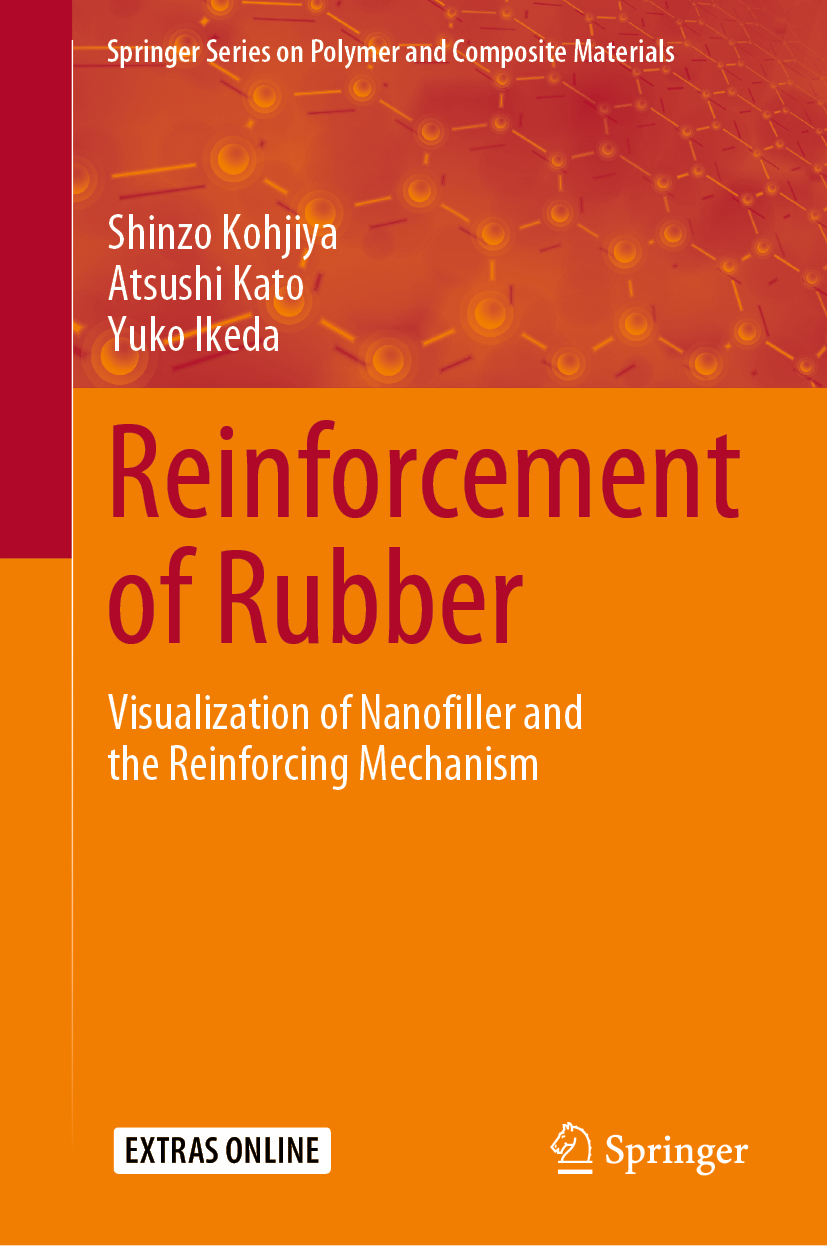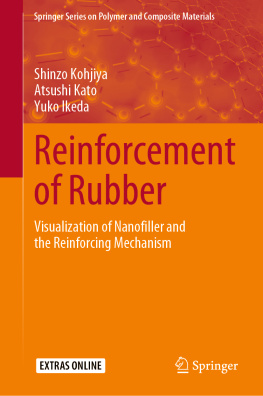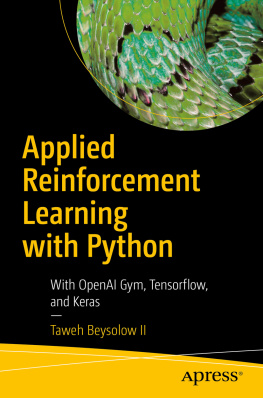Shinzo Kohjiya - Reinforcement of Rubber Visualization of Nanofiller and the Reinforcing Mechanism
Here you can read online Shinzo Kohjiya - Reinforcement of Rubber Visualization of Nanofiller and the Reinforcing Mechanism full text of the book (entire story) in english for free. Download pdf and epub, get meaning, cover and reviews about this ebook. year: 2020, publisher: Springer Nature, genre: Children. Description of the work, (preface) as well as reviews are available. Best literature library LitArk.com created for fans of good reading and offers a wide selection of genres:
Romance novel
Science fiction
Adventure
Detective
Science
History
Home and family
Prose
Art
Politics
Computer
Non-fiction
Religion
Business
Children
Humor
Choose a favorite category and find really read worthwhile books. Enjoy immersion in the world of imagination, feel the emotions of the characters or learn something new for yourself, make an fascinating discovery.
- Book:Reinforcement of Rubber Visualization of Nanofiller and the Reinforcing Mechanism
- Author:
- Publisher:Springer Nature
- Genre:
- Year:2020
- Rating:4 / 5
- Favourites:Add to favourites
- Your mark:
- 80
- 1
- 2
- 3
- 4
- 5
Reinforcement of Rubber Visualization of Nanofiller and the Reinforcing Mechanism: summary, description and annotation
We offer to read an annotation, description, summary or preface (depends on what the author of the book "Reinforcement of Rubber Visualization of Nanofiller and the Reinforcing Mechanism" wrote himself). If you haven't found the necessary information about the book — write in the comments, we will try to find it.
Shinzo Kohjiya: author's other books
Who wrote Reinforcement of Rubber Visualization of Nanofiller and the Reinforcing Mechanism? Find out the surname, the name of the author of the book and a list of all author's works by series.
Reinforcement of Rubber Visualization of Nanofiller and the Reinforcing Mechanism — read online for free the complete book (whole text) full work
Below is the text of the book, divided by pages. System saving the place of the last page read, allows you to conveniently read the book "Reinforcement of Rubber Visualization of Nanofiller and the Reinforcing Mechanism" online for free, without having to search again every time where you left off. Put a bookmark, and you can go to the page where you finished reading at any time.
Font size:
Interval:
Bookmark:

The Springer Series on Polymer and Composite Materials publishes monographs and edited works in the areas of Polymer Science and Composite Materials. These compound classes form the basis for the development of many new materials for various applications. The series covers biomaterials, nanomaterials, polymeric nanofibers and electrospun materials, polymer hybrids, conducting polymers, composite materials from macro- to nano-scale, and many more; from fundamentals, over the synthesis and development of the new materials, to their applications. The authored or edited books in this series address researchers and professionals, academic and industrial chemists involved in the areas of Polymer Science and the development of new Materials. They cover aspects such as the chemistry, physics, characterization, and material science of Polymers, and Polymer and Composite Materials. The books in this series can serve a growing demand for concise and comprehensive treatments of specific topics in this rapidly growing field.
More information about this series at http://www.springer.com/series/13173

This Springer imprint is published by the registered company Springer Nature Singapore Pte Ltd.
The registered company address is: 152 Beach Road, #21-01/04 Gateway East, Singapore 189721, Singapore
This book is the most recent account on rubber reinforcement, highlighting nanofiller clustering in rubber matrix, in particular. It is needless to say that the rubber reinforcement has been recognized to be one of the most important research and developmental subjects among rubber chemists and engineers, together with vulcanization. On the one hand, the vulcanization is an indispensable precondition for rubber in order to make it serviceable as a stable elastic material. It was invented in 1839 by C. Goodyear when a rubber compound containing sulfur and white lead was by chance placed beside the heater which his wife, Clarissa, was using in the kitchen. This anecdote suggests that the kitchen was his laboratory, and he was not a professional technician but a poor backstreet inventor.
On the other hand, reinforcement of rubber by carbon black was reported by S. C. Mote in 1904 in the UK not as an invention but as a practice in rubber compounding process in combination with fiber cord, in order to manufacture automobile tires as a final product. In 1910, the Diamond Rubber Co. in Akron, Ohio, took out a license of this process, followed by the acquisition of the business by B. F. Goodrich in the USA. It is noticeable that the first mass-produced passenger car for ordinary people, i.e., Ford model T was commercialized in 1908. In accordance with the development of mass production of automobiles, the utilization of carbon black grew rapidly in the rubber industry, and black color soon became standard for tires.
Thus, due to the utmost technical importance of rubber reinforcement by loading carbon black, there have been published many, too many, technical reports and know-how to give a lucid and coherent explanation of reinforcing effect on rubber. In other words, the excessively abundant reports have failed to elucidate the exact reinforcing mechanism, which is to be of use in designing rubber compounds. Consequently, only one book entitled Reinforcement of Elastomers has been published so far focusing upon rubber reinforcement, in 1965. The book was edited by G. Kraus, and it has remained to be authoritative on rubber reinforcement for more than half a century. This surprising scanty of the dependable literatures of rubber reinforcement may be due to the extreme complexity of reinforcing mechanism, we have assumed.
The present book discloses a most recent trial to overcome this complexity by visualizing the three-dimensional (3D) image of nanofillers in rubber matrix, which has been enabled by applying a state-of-the-art technique using 3D transmission electron microscopy (3D-TEM), or alternatively called electron tomography, to rubber/nanofiller composites. Through the analysis of 3D images displaying nanofiller dispersion, we have successfully visualized the aggregation state of nanofillers in rubber matrix, from which we suggest the formation of a unique semiflexible nanofiller network. This result is reasonably assumed to be the most important factor for rubber reinforcement by filler loading. In the case of cross-linked natural rubber, self-reinforcement effect (without any filler loading) upon stretching is effectively functioning, and a new polymer crystallization mechanism, template crystallization, is suggested for the strain-induced crystallization responsible for the unique self-reinforcement.
From the meaning of the word reinforcement itself, engineering investigation based on fracture mechanics should be one of the approaches to the elucidation of rubber reinforcement. However, fracture mechanical studies on rubber materials have not been much successful so far, compared with those on metallic and inorganic materials. We hope that our results presented in this book may accelerate studies for establishing the fracture mechanical behaviors of rubber. In addition, reinforcement of rubber justifiably involves not only mechanical strength but also various functional properties: For example, the required functions of the tread rubber of pneumatic tires in driving include lots of dynamic properties such as traction, grip, rolling resistance, skid resistance, wear of rubber, and so on. Hence, only mechanically supporting the weight is absolutely insufficient for automobile and aircraft tires.
Font size:
Interval:
Bookmark:
Similar books «Reinforcement of Rubber Visualization of Nanofiller and the Reinforcing Mechanism»
Look at similar books to Reinforcement of Rubber Visualization of Nanofiller and the Reinforcing Mechanism. We have selected literature similar in name and meaning in the hope of providing readers with more options to find new, interesting, not yet read works.
Discussion, reviews of the book Reinforcement of Rubber Visualization of Nanofiller and the Reinforcing Mechanism and just readers' own opinions. Leave your comments, write what you think about the work, its meaning or the main characters. Specify what exactly you liked and what you didn't like, and why you think so.










